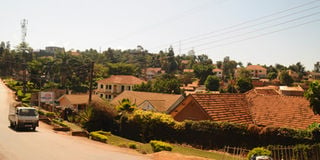Pricey office spaces send tenants to residential areas

Offices along Naguru go-down lane. Knight Frank’s report for Kampala, shows that occupancy rates for prime residential suburbs of Nakasero, Kololo, Naguru, Mbuya and Bugolobi increased from 69 per cent recorded in the first half of 2018 to 78 per cent in the first half of 2019. FILE PHOTO
What you need to know:
- To skip the morning traffic jam, tenants are now settling for office spaces out of the Central Business District (CBD) of Kampala in “reasonably” priced buildings in residential suburbs. But what does this shift mean for property developers in the CBD whose properties remain under-occupied?
With no end in sight to Kampala’s traffic jam, businesses are gradually moving out of the Central Business District (CBD) to rent office space.
The escalating price of office space coupled with inadequate parking space within the capital city have also pushed tenants to migrate to residential suburbs.
This means property developers in the CBD should be mindful about constructing office spaces that will only increase the existing under-occupied buildings.
Some residential landlords in Kampala have quickly identified the gap and taken advantage of it.
Mr John Muwanguzi, a landlord in Kawempe - a Kampala suburb, turned his residential unit into office space when he realised that the demand for cheaper office space closer to the city is high.
“More people approached me to rent my property as office space,” he said.
Mr Muwanguzi found this a better option since such tenants usually offered a cash down payment compared to residential tenants. And the profit was worth it.
“In most office spaces in the city, landlords want rent to be paid in dollars so some end up this side of town where they pay in shillings,” he says.
Ms Henrietta Kisekka used to work for a media agency but lost her job. But when she wanted to start a business, she could not find affordable spots in the CBD.
After a long search, a friend directed her to a residential place which the owners had left and turned into offices.
“I wanted to start a stationery shop. But finding affordable space in arcades was hard. So I tried some residential place in upper Nakasero and that’s where I operate from,” she says.
A mini-survey around the city shows that most businesses operating in residential areas include food vending, stationery supplies, law firms, Non-Governmental Organisations and start-ups.
Mimi Muhairwe, a trader in a Kampala suburb,believes that the demand for office space is on the rise because people are venturing into side businesses in addition to employment.
Muhairwe said; “Rent is high yet some landlords are not predictable. They increase rent whenever they want and when they get a client who will pay them more, they will find ways of chasing you.”
Ms Judy Rugasira Kyanda, Knight Frank Uganda’s managing director, admits that there is a trend of people turning their homes into office spaces for rent.
But she says such arrangements are so small that their impact is not felt in the real estate business.
“The not-so-corporate, NGOs and start-ups are going for that but this has little impact. There is still a huge demand of office space both in the CBD and suburbs; renting residential for office is negligible,” she said.
Findings
Knight Frank’s report for Kampala, shows that occupancy rates for prime residential suburbs of Nakasero, Kololo, Naguru, Mbuya and Bugolobi increased from 69 per cent recorded in the first half of 2018 to 78 per cent in the first half of 2019.The first half refers to the calendar period January 1 to June 30.
The same report shows that there was an increase in expatriate accommodation for singles and couples, for two bedroom units. This led to a 7 per cent increase in rent prices from an average of $2,100 (Shs7.7m) registered in first half of 2018 to $2,250(Shs8.2m) in first half of 2019.
Occupancy rates for office space in Kampala grew by 2 per cent due to grade B+ space.
This was largely helped by a “soft” market that allowed customers to drive harder bargains for lower rental rates in conjunction with good location, accessibility and ample parking space.
“The increase in occupancy of Grade B+ properties is on account of tenants taking advantage of a soft office market at present to drive harder bargains for lower rentals, particularly for less prime properties,” stated part of the report.
Knight Frank also noted that other key drivers of office take-up include good location and accessibility, ample parking, space configuration and functionality, professional property management services plus the quality of services and facilities at the properties for rent.
Residential prices
Statistics from Uganda Bureau of Statistics (UBOS) indicate that residential property prices registered a growth rate of 9.4 per cent for the year ending March 2019 compared to 7.1% registered for the year ended December 2018.
According to Nakawa Mayor Mr Ronald Balimwezo, unlike in the past where land used to be the biggest investment asset, today people are investing in property.
Balimwezo argues that infrastructural developments and reliable electricity supply in the outskirts of Kampala has enticed people to leave the city and because of limited quick returns, some homes have been turned into offices.
“This has forced people to turn residential properties and areas into commercial properties hence making them cheaper than those in urban areas which lack parking space,” Balimwezo added.
Expert’s view
Abdu-Wahab Nyanzi, an architect, Jr Consultants, says decision for companies to relocate or opt for office space outside the CBD are diverse mainly due to the cost of space.
“The amount of space you get in the suburbs is more compared to the CBD. For example, one can get a full house of 150 square metres for Shs2 million per month in the suburbs while the same money gets your only 12sqm in the city,” Nyanzi explains.
He adds that in the city centre, the inconvenience of traffic and limited parking space complicate it.
For a business that doesn’t need to display or rely on walk-in clients, there is no reason for them to stay in the city centre.
“Businesses are working smarter, relying on the virtual market and the more dependable courier network today to move goods,” he notes, adding that trading online is taking root.
Adapting to trends
Explaining the new shift in office space, Nyanzi notes that this trend of events suggests that developers should be advising clients on the new ways of developing property.
He says: “The kind of development one sets up in a radius of 20Km from the CBD should be looked at critically.”
In addition, the architect should ensure that such a development shall remain relevant to the trends at least 20 years later.
On the other hand, Nyanzi says that architects need to have critical analysis on the state of the CBD because the city authority is making a lot of changes that are affecting the way people experience the city.
For example, the flyovers, the pedestrian avenues, the Sunday street markets and more are aspects that architects have to consider when designing.
He notes that architects should also already be looking at ways of keeping the CBD relevant and alive.
“The city needs to remain attractive to a variety of people in whatever way. It cannot be left to buses and trucks picking goods,” Nyanzi says, adding that it is the duty of architects to design spaces that shall give life to the CBD in future.




